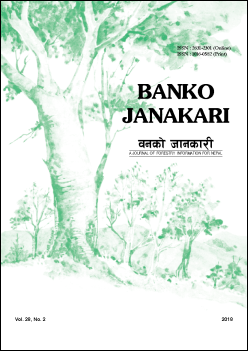Effect of growth hormone and growth media on the rooting and shooting of Zanthoxylum armatum stem cuttings
DOI:
https://doi.org/10.3126/banko.v28i2.24183Keywords:
Growth hormones, growth media, sprouting, stem cuttings, rooting, Zaanthoxylum armatumAbstract
The common method of propagation is through seeds but seed germination in Zanthoxylum armatum is very low due to the presence of hard seed coat, which might be a great hurdle for large scale production of plantlets. So an attempt was made in this study to see the effect of different growth hormones, their concentrations and different rooting media on the rooting and sprouting of Z. armatum. The stem cuttings of Z. armatum were treated with two types of auxins namely Indole-3-Butyric Acid (IBA) and Naphthalene Acetic Acid (NAA) at different concentrations (2000 ppm, 3000 ppm and 5000 ppm), while the untreated cuttings were used as control. The cuttings were planted in three different rooting media: sand, neopeat and mix (containing a mixture of sand, soil and vermin-compost). The completely randomized design was used for the experiment. The total number of stem cuttings of Z. armatum used in the experiment was 1080 for 18 treatments in three replicates (20 cuttings per treatment x 18 treatments x 3 replicates). The experiment was set up in controlled greenhouse conditions at Dabur Nepal Private Limited Nursery, Banepa, Kavre District. The parameters evaluated were root length, shoot length and number of roots per cutting. The collected data were analyzed statistically using R-program with Agricola. Least significant difference (LSD) and Duncan multiple Range Test (DMRT), as mean separation technique was applied to identify the most efficient treatment in the rooting and shooting behavior of Z. armatum (Gomez and Gomez, 1984). Hormone concentration and growth media significantly affected the rooting and shooting ability of Z. armatum stem cuttings. IBA was found to be more effective than NAA. Neopeat medium was better than sand and mix media. The highest number of roots (6.5) and root length (11.6 cm) were recorded under IBA 5000 ppm in neopeat medium.
Downloads
Downloads
Published
How to Cite
Issue
Section
License
© Forest Research and Training Centre, Ministry of Forests and Environment, Nepal




